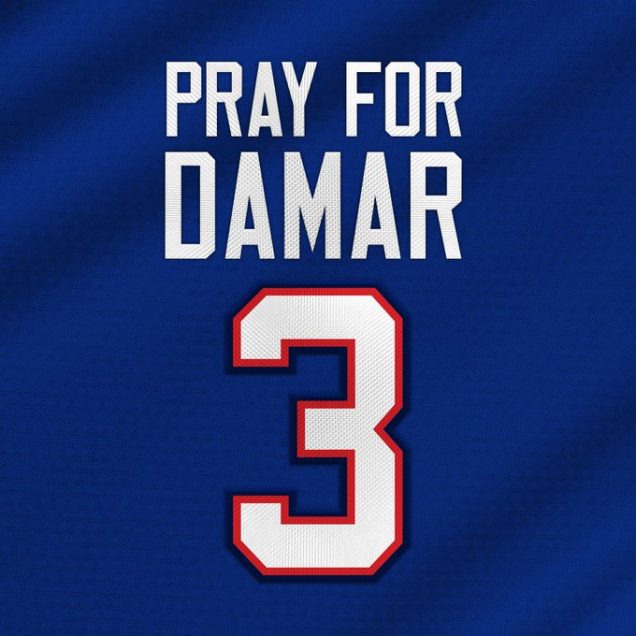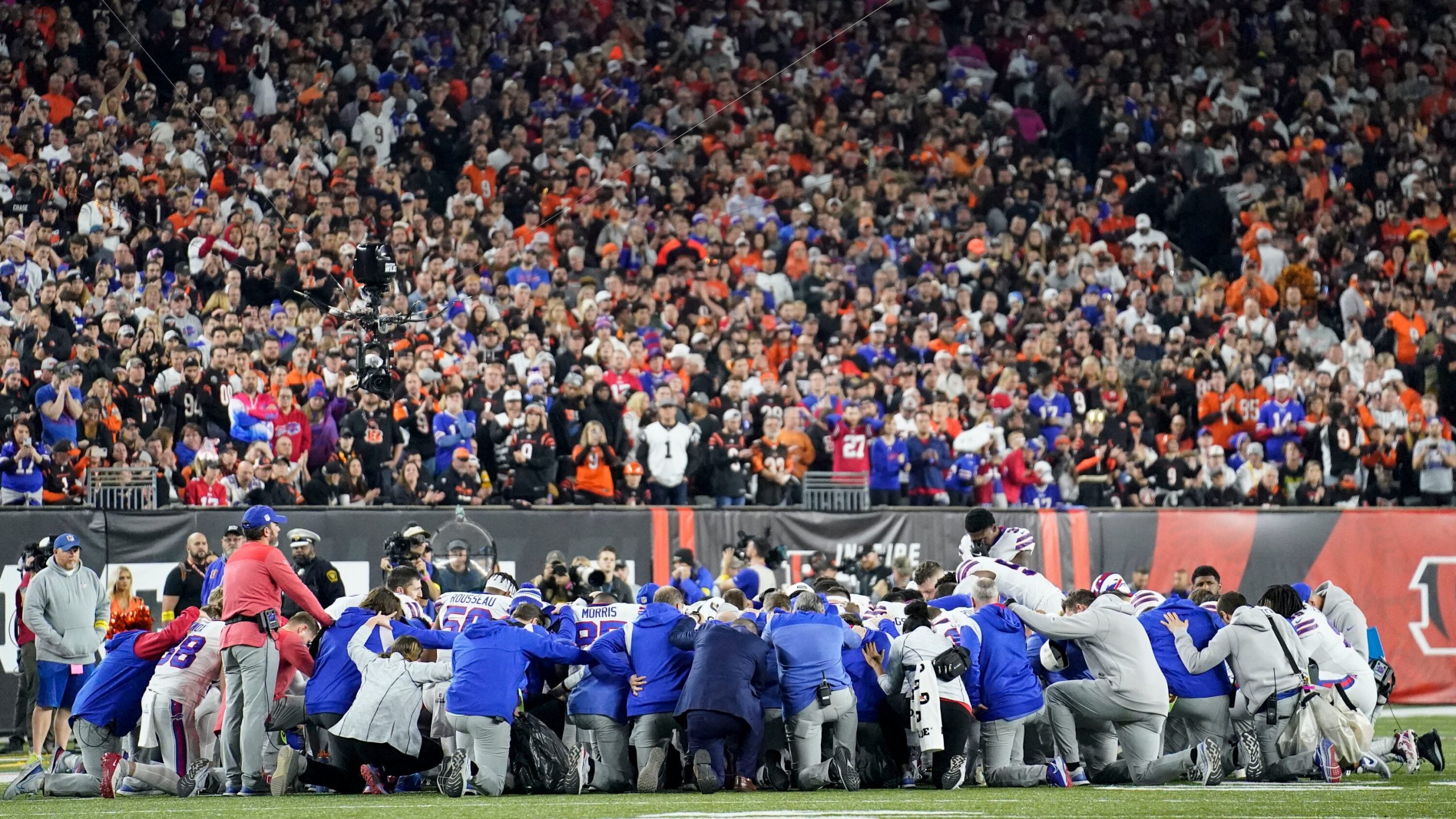The B-Gap: Damar Hamlin’s collapse a reminder that sports cannot escape reality
By Sam Robb O’Hagan
This column is supposed to be on NFL topics that aren’t getting enough attention. It’s supposed to surprise, to bring to light crucial developments across the league that are falling under the radar.
There is no surprise this week, for there is nothing else to write about. The NFL is in its darkest hour; its entire operation has come to a horrifying halt following the on-field cardiac arrest of Bills’ second-year safety Damar Hamlin on Monday Night Football. As Kevin Clark acknowledged in a wonderful piece for The Ringer, never before has the NFL been forced to stop the football, never before has the NFL been simply incapable of playing on. There was no precedent for this, and yet, such is the gravity of the situation, there was never a shadow of a doubt as to what steps would be taken next. Per NFL Network’s Tom Pelissero, NFL Executive Vice President Troy Vincent said “it never crossed our mind to talk about warming up to resume play.”
The entire NFL business, usually so notoriously unsympathetic, finds itself united in prayer for the still unknown status of Hamlin. According to a tweet from the Bills sent out at 1:48 AM on Tuesday, Hamlin’s heartbeat was restored after first-responders administered CPR on the field, and he is now sedated at UC Medical Center and is in critical condition. All 32 of the NFL’s franchises have tweeted out their thoughts and prayers, so to numerous players from both the Bills and Bengals, including wide receiver Tee Higgins, who delivered the tragically innocent hit that sent Hamlin into cardiac arrest. The Bills tweeted out a touching graphic that included over 40 different tributes to Hamlin from around the league about 90 minutes after he collapsed, and it doesn’t even begin to encapsulate the sheer volume of prayers sent out by the collective NFL community.

No conversation surrounding the sport in the near 39 hours since Hamlin’s injury has escaped the ongoing medical emergency — not a word on the eventual result of one of the most significant games of the season, which as Roger Goodell announced on Tuesday will not be decided this week, or any consideration on the last weekend of the season that lies ahead, which will decide the fate of eight different teams fighting for a playoff spot. The announcement of the 15 Pro Football Hall of Fame finalists for the class of 2023 originally scheduled for 8 PM on Tuesday, was postponed to an undecided future date because right now, it simply doesn’t matter. None of it matters.
And not just the NFL world, but the entire American sports world, too. LeBron James, moments after a 43-point performance in a critical win for the Los Angeles Lakers, was asked by reporters for his thoughts on Hamlin’s situation, assuming the news had already reached James and the uninvolved Lakers locker room. James delivered a somber nod, a confirmation that the Lakers’ first exposure to the outside world following their game against the Charlotte Hornets were the scenes in Cincinnati.
If you were watching SportsCenter Tuesday morning, all but two minutes of the hour-long broadcast cycle was reserved for coverage of Hamlin and the mourning Bills organization. Just 120 seconds were spent on other stories from around American sports, which included Cavaliers guard Donovan Mitchell becoming just the fifth player since Wilt Chamberlain to score 70 points in an NBA game and Warriors guard Klay Thompson making 10 threes in a 54-point performance against the Hawks. Like the still unresolved NFL season, none of it mattered.
So here the sports world stands, normally so blissfully detached from reality, now without any choice but to confront the humanity of one of the athletes that risks so much to deliver such trivial entertainment. And here the sports world waits, powerlessly awaiting an end to the ongoing effort to recover the life of one of its own, never more desperate for the privilege to just play a game.
Hamlin isn’t the first athlete to go into cardiac arrest in the middle of play, many watching on Monday night were also watching the European Championships in 2021, when Denmark’s Christian Eriksen collapsed on the field and received CPR to the evident horror of his compatriots, both his teammates and the Danish fans in the stands. Eriksen was stretchered off the field clearly awake, alive enough to to raise a thumbs up and end the soccer world’s collective fear for his life and allow it to go back to playing their game.
This was different. Hamlin remains in critical condition and the American sports world has no confirmation on the resolution to the fight for his life. The last images the public has seen of Hamlin were of him falling back to the Paycor Stadium turf, the only images of his emergency since have been of the unsettlingly anonymous ambulance carrying him off the field and the uncontrolled tears of his Bills’ teammates.
And it all happened at the peak of the NFL’s on-field drama, in the first quarter at an electric stadium on one of the most anticipated nights of the season. There were division titles on the line, number one seeds on the line, even Fantasy Football Championships on the line, all functions of the irresistible fantasy of professional sports. With one fall, all of it was gone.
For an industry that always wants to play on, sports in the United States are now at the mercy of a long, grueling process that is completely out of their control. Sports win their bread between the lines, selling their captivated audience on the endless and innocent drama of their perfect on-field meritocracy. Hamlin’s collapse was a chilling reminder of just how fast that drama can go from innocent to guilty. The ambulance on Monday night didn’t just carry Hamlin off the field and into the hospital, but it carried the entire sports world, too.
There is no precedent in sports for what it has just witnessed, as the events of Monday night escaped the confines of the game the moment ESPN’s cameras panned to the faces of Hamlin’s teammates, an unquestioned sign that this time was different. As Hamlin remains in critical condition, the NFL and the rest of American sports can no longer live in innocence between their lines. Instead they find themselves in direct contact with the reality of their world and the humanity of their athletes, the lone two areas they have yet to be forced to confront.
As Benjamin Abella, an Emergency Room doctor and CPR professor at the University of Pennsylvania warned on Twitter, the post-arrest care required to fully recover Hamlin’s life is “slow and careful work,” and it could take as long as a week for confirmation on Hamlin’s condition. Any hopes throughout the industry of a return to normality is likely a painful number of days away.
And so the NFL waits, as questions that ought to have been answered a long, long time ago will now be asked with more conviction than ever before: Just how dangerous is the sport of football? How much of a consideration is the safety of the NFL’s players? How can the NFL continue to play when the smaller hits, the ones that aren’t as immediately traumatizing but still carry with them long-term consequences, continue to accumulate every time two teams take the field? How can the NFL expect Hamlin’s teammates — no doubt central characters in the late season drama this business is built upon — to even return to the field at all?
There will continue to be thoughts and prayers, but there will also be plenty of lessons to be learned and questions to be answered on the guilt-ridden reality of a supposedly innocent game. And so, we wait. We wait not for the NFL’s return to the field, but for the preservation of the humanity of a truly special individual, and for answers on how the industry can possibly grapple with what just happened to him.
